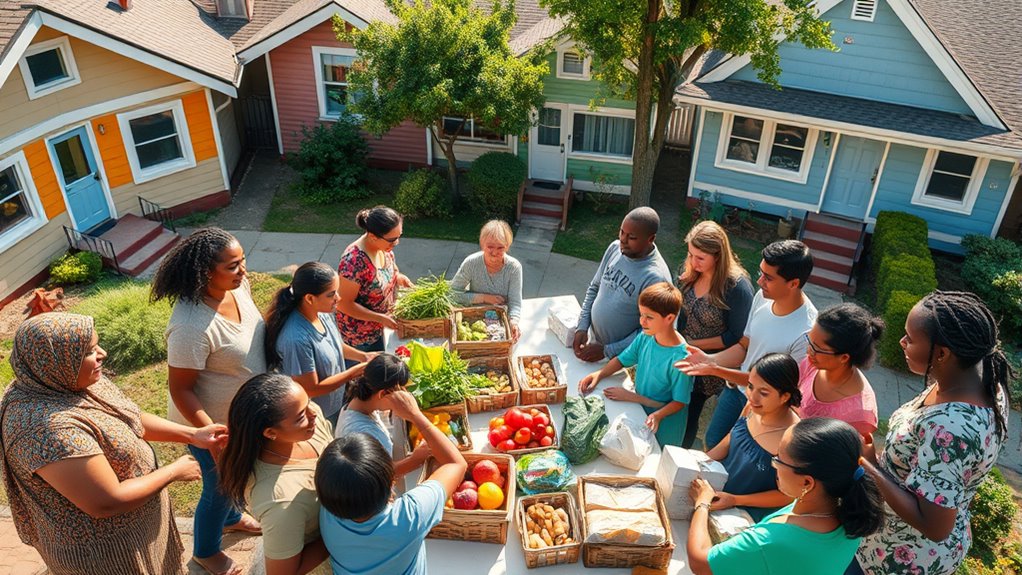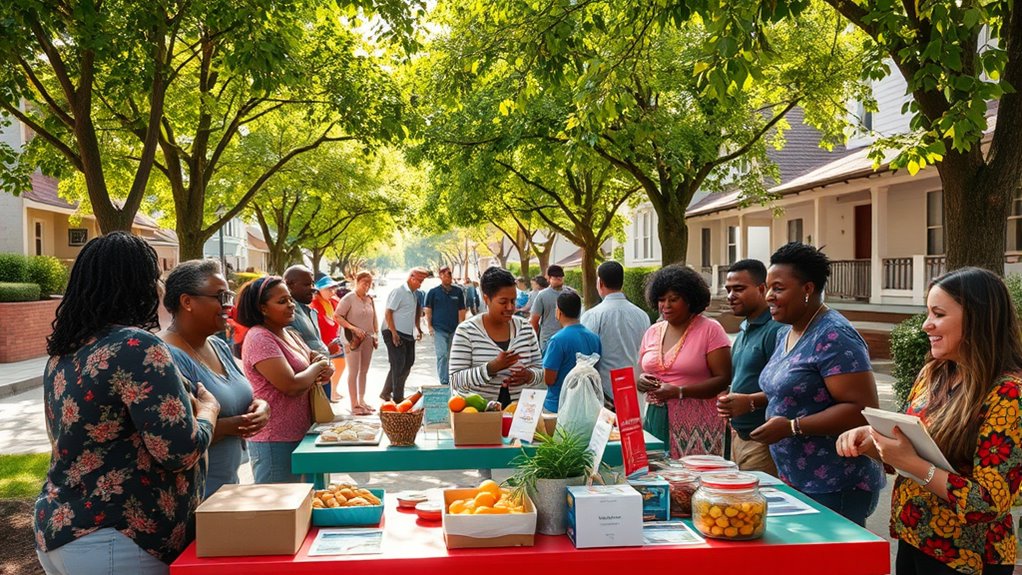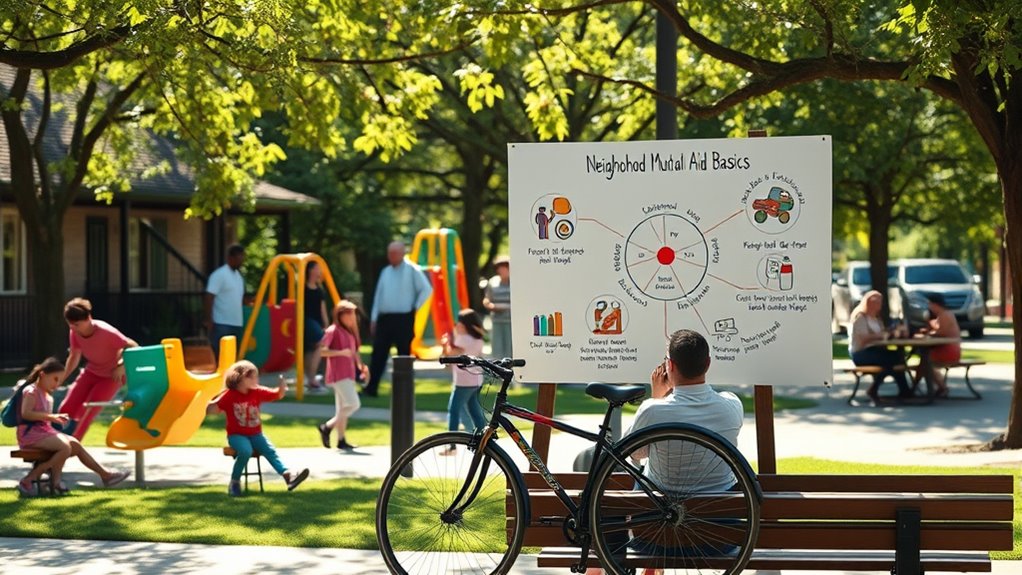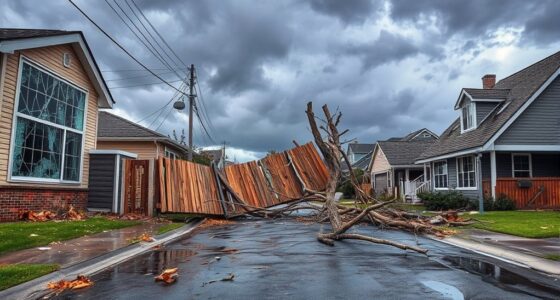Neighborhood mutual aid is when neighbors support each other directly by sharing skills, resources, and help without relying on charities or government programs. It focuses on building a stronger community through reciprocity, where everyone gives and receives. You can share tools, lend a listening ear, or help with errands. Starting this involves talking to neighbors and organizing small efforts. Keep exploring to discover easy ways you can join or start a mutual aid network nearby.
Key Takeaways
- Neighborhood mutual aid is neighbor-led support that shares resources, skills, and help without relying on charities or government programs.
- It focuses on reciprocity, empowering residents to both give and receive assistance within their community.
- Support can include lending tools, sharing produce, emotional encouragement, or helping with errands.
- Communities start by talking to neighbors, organizing small meetings, and spreading awareness through various channels.
- Benefits include stronger bonds and resilience, while challenges involve coordinating efforts and maintaining participation.
What Is Neighborhood Mutual Aid?

What exactly is neighborhood mutual aid? It’s a form of community organizing where neighbors come together to support each other without relying on traditional charities or government programs. Instead, you build grassroots networks that focus on meeting local needs directly. These networks are created by residents who identify common issues and work collaboratively to find solutions. Mutual aid emphasizes reciprocity—everyone gives and receives help—strengthening community bonds. Rather than waiting for outside assistance, you and your neighbors take action, sharing resources, skills, and time. This approach fosters a sense of empowerment and resilience within the neighborhood. In essence, neighborhood mutual aid transforms passive recipients into active participants in shaping their community’s well-being. Developing a proactive mindset is essential for taking consistent action and building sustainable support systems.
How Does Mutual Aid Differ From Traditional Help or Charity?

Unlike traditional charity or aid, mutual aid is rooted in active community participation rather than external assistance. This approach emphasizes community empowerment, where neighbors work together to meet each other’s needs. Instead of relying on outside organizations, mutual aid focuses on resource sharing within the community, creating a sense of collective responsibility. You’re not just a recipient; you’re a participant, helping others and strengthening community bonds. Traditional help often involves top-down support, which can foster dependency. In contrast, mutual aid builds resilience by encouraging everyone to contribute what they can. This shared effort fosters trust, equality, and a deeper connection among neighbors. Overall, mutual aid transforms help into a collaborative, empowering process rooted in your community’s strengths.
What Kinds of Support Can Neighbors Share With Each Other?

Neighbors can share a wide range of support to strengthen their community and help each other through everyday challenges. Community resource sharing is a common way neighbors assist one another, whether it’s lending tools, sharing extra produce, or offering space for events. Besides tangible resources, emotional support plays a crucial role, helping neighbors feel connected and cared for during tough times. You might listen to someone’s concerns, offer encouragement, or simply be there when someone needs a friend. Small acts like checking in or providing a helping hand can make a big difference. Sharing electric bikes or their accessories can also be a helpful way to promote eco-friendly transportation options within the neighborhood. These shared supports build trust and resilience within your neighborhood, creating a safer, more connected environment where everyone feels valued and supported.
How Do Communities Start or Get Involved in Mutual Aid Efforts?

Getting a community involved in mutual aid efforts often starts with simple steps. You can begin by talking to neighbors and listening to their needs, fostering community engagement. Organize small meetings or gatherings to discuss shared concerns and ideas. Grassroots organizing is key—empowering residents to take ownership and lead initiatives. Use flyers, social media, or word-of-mouth to spread the word and invite participation. Building trust and relationships creates a strong foundation for mutual aid projects. Focus on inclusive approaches that welcome diverse voices. Start with manageable goals, like sharing resources or coordinating errands, and expand as more people join. Remember, community involvement grows from collective effort, shared purpose, and consistent engagement. Recognizing the importance of community trust can significantly enhance the effectiveness of mutual aid efforts.
What Are Some Benefits and Challenges of Neighborhood Mutual Aid?

Neighborhood mutual aid offers many benefits, such as strengthening community bonds, increasing resilience, and providing immediate support during emergencies. By working together, you boost local resilience, helping everyone recover faster from crises. It also fosters community empowerment, giving residents a sense of control over their safety and well-being. Additionally, utilizing appropriate projector technology can enhance community gatherings and presentations, making communication more effective. However, challenges exist. Coordinating efforts can be difficult, especially if members have different priorities or limited resources. Sustaining participation over time may also be tricky, and some may question whether mutual aid replaces formal services. Despite these hurdles, the overall impact is positive, making your neighborhood more connected and better prepared. Recognizing both benefits and challenges helps you build more effective and resilient mutual aid networks that support everyone in your community.
Frequently Asked Questions
How Can I Ensure Mutual Aid Efforts Remain Inclusive and Accessible to All Residents?
To keep mutual aid efforts inclusive and accessible, you should actively address language barriers by providing multilingual materials and translation support. Focus on accessibility improvements by ensuring events and resources are physically accessible for everyone, including those with disabilities. Engage diverse community members in planning, listen to their needs, and adapt your outreach strategies accordingly. This proactive approach helps create an environment where all residents feel welcome and can participate fully.
What Legal Considerations Should Neighborhoods Be Aware of When Organizing Mutual Aid?
Think of legal considerations as a safety net beneath your community’s efforts. You should address liability concerns by clearly defining roles and obtaining necessary insurance, like a sturdy safety net. Protect residents’ privacy by following data protection laws and securing personal information. Keep documentation of activities and agreements to prevent misunderstandings. Staying informed about local regulations and consulting legal experts guarantees your mutual aid initiative remains compliant and secure for everyone involved.
How Do Mutual Aid Groups Handle Disagreements or Conflicts Within the Community?
When conflicts arise, you should prioritize conflict resolution through open community dialogue. Encourage everyone to share their perspectives calmly and listen actively. Facilitating respectful conversations helps find common ground and resolve disagreements effectively. If needed, involve neutral mediators from within the community to facilitate the dialogue. This approach guarantees that conflicts are addressed constructively, strengthening trust and cooperation within your mutual aid group.
What Funding Options Are Available to Sustain Neighborhood Mutual Aid Initiatives?
You can obtain funding through grant opportunities offered by local governments or nonprofits, helping sustain your neighborhood mutual aid. For example, a community group successfully applied for a city grant to fund their food distribution program. Additionally, fundraising strategies like online campaigns, benefit events, or donations from local businesses can generate ongoing support. Combining these methods ensures your initiative remains resilient and well-funded to meet community needs.
How Can Technology Be Used Effectively to Coordinate Mutual Aid Activities?
You can use digital platforms like messaging apps, shared calendars, and project management tools to coordinate mutual aid activities efficiently. These tools help you organize events, share resources, and communicate quickly. Just remember to prioritize data privacy by using secure platforms and limiting personal information sharing, ensuring your community’s safety while staying connected and effective in your mutual aid efforts.
Conclusion
Neighborhood mutual aid empowers you to build stronger connections, support your neighbors, and create resilient communities. It’s about giving and receiving, sharing and caring, helping and healing. By getting involved, you foster trust, foster kindness, and foster change. So, take action, reach out, and join the movement—because when you help your neighbors, you help yourself. Together, you can create a community that’s safer, kinder, and more united for everyone.









